Why do Tree Swallows use nest boxes?
- Cavity-nesting birds like Tree Swallows, that can’t make their own cavities, usually face a shortage of nest sites.

- Competition for cavities can be intense, even a matter of life and death, since failing to reproduce is a critical failure for short-lived songbirds.
- Tree Swallows must compete with other Tree Swallows for nest sites, and also with other cavity-nesters like Bluebirds, House Wrens, Starlings and House Sparrows.
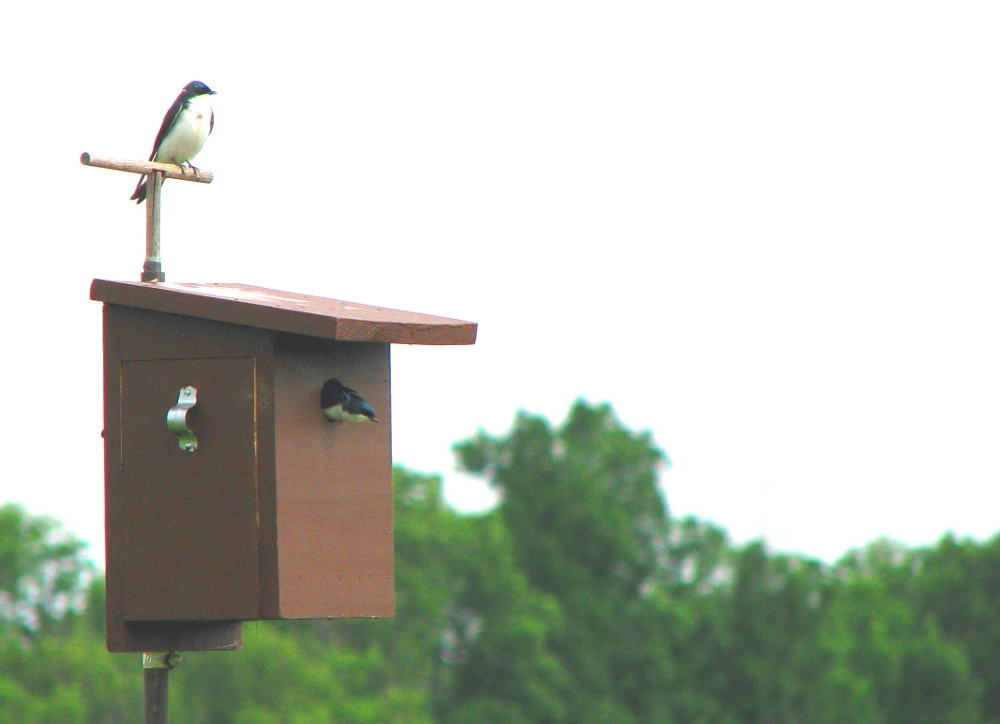
- Since natural cavities are scarce, Tree Swallows quickly accept nest boxes, and unlike some other cavity-nesting species, they aren’t picky. They’ll try to use just about any cavity, natural or man-made, they can get into.
- Tree Swallow nests have been found in large boxes meant for Purple Martins, Wood Ducks and Screech Owls, and in such unlikely spots as drain pipes, mailboxes and newspaper tubes (photo below by Laura Niang in Maryland).
- Sadly, they’ll also try to nest in tiny or flimsy boxes where few or no young survive.
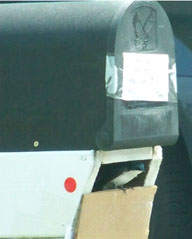
If you decide to build nest boxes yourself, be sure to use designs suitable for Tree Swallows.
- You’ll want to build boxes carefully using good materials.
- You want your swallows to be safe from predators, and also protected from rain, cold, and heat.
- And it’s important that boxes be roomy enough so parent swallows can raise full broods of strong, healthy young.
ATTENTION
For many years, we recommended two nest box designs for Tree Swallows, the Golondrinas Box and the Long Point Box, and we provided links to plans for making them. However, we have decided to switch our choice to another design, the Basic Tree Swallow Box (see below), which we believe is even better.
Click here for the Basic Tree Swallow Box plan.
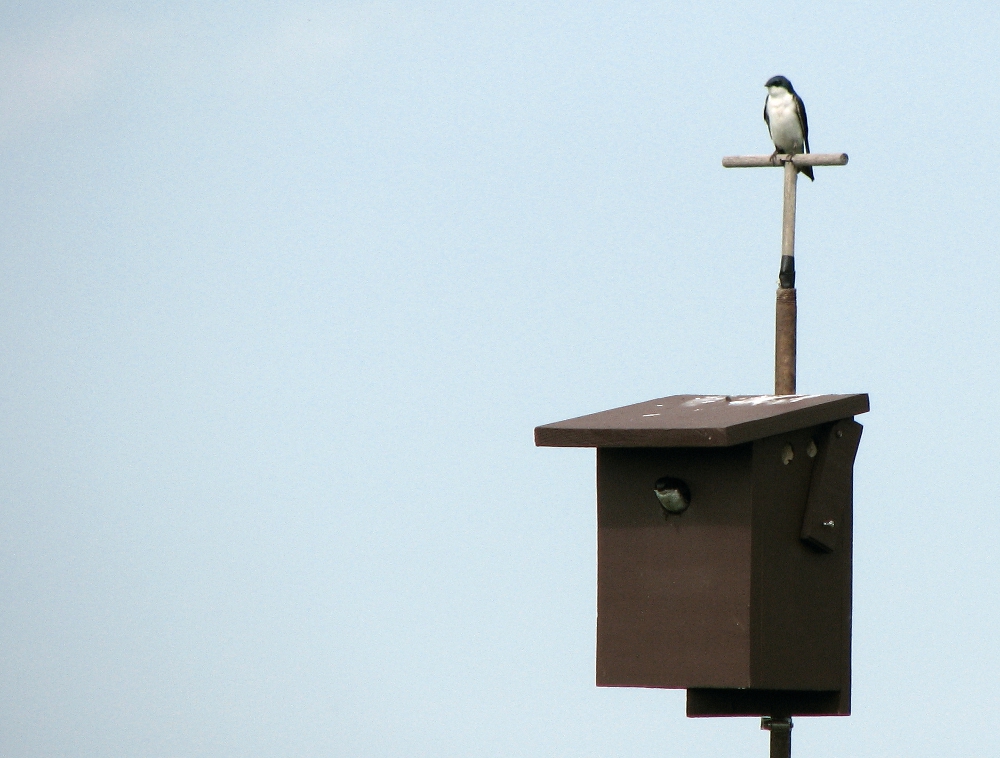
No matter what design you use, all Tree Swallow boxes should have:
- Sturdy wood construction using 1″ rough-cut boards or plywood (exterior-grade only) no less than 1/2″ thick, preferably thicker.
- 1-3/8″ to 1-1/2″ entrance holes to keep larger birds out.
- Entrance holes centered about 7″ above floors.
- Floors NEVER SMALLER than 5″ x 5″. (Our Basic Box floors are 6″ x 5-1/2″).
- Roofs that slope down and overlap sides and fronts. This reduces exposure to rain and makes it harder for predators to reach inside.
- Sides that swing open for easy checking of box contents and cleaning. We prefer doors that open at the top and swing down.
- Floors recessed to minimize interior wetness.
- Unpainted or unstained interiors.
- Roughened, kerfed, or cleated front interiors beneath entrances to provide nestling footholds. We do not use screen or hardware cloth for this.
- No entrance hole perches that could aid predators.
- Adjustable ventilation to help control within-box temperature.
WARNING! DON’T MAKE OR BUY BOXES THAT ARE TOO SMALL!
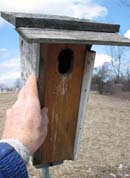
NO! Both these two bluebird-type boxes have interiors that are much too small for Tree Swallows

- Many published box plans and boxes sold in stores are intended for bluebirds, which are larger than swallows but average fewer nestlings per brood.
- Recently some bluebird hobbyists have advocated using very small boxes in a well-intended but futile attempt to prevent box use by House Sparrows.
- DON’T use these little boxes for Tree Swallows! They have interiors that are far too small for swallow broods of up to seven young.
- You may meet people who say the small bluebird boxes are just fine for Tree Swallows. They are NOT ok! While it is true Tree Swallows will eagerly accept small boxes, their nestlings may not thrive or fledge successfully.
What’s wrong with small interiors in nest boxes for Tree Swallows?
- Boxes with small internal volumes put nestlings at risk of death from overheating during hot spells because the nestlings can’t spread out to cool themselves.
- Smaller nestlings may get trampled by larger siblings, have their feathers soiled with feces, and be unable to reach food brought by parents.
- Swallow nestlings also require space to exercise their wings so they can fly strongly when they fledge.
- It’s possible lack of space may even interfere with proper bone and feather development.
- Imagine six or seven swallow nestlings trying to survive inside the tiny bluebird tube below! (Photo from Craig A. Mullenbach of Mully410Images).
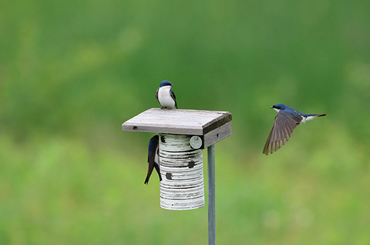
- Nest boxes with small interiors can also be detrimental to adult swallows.
- Note the badly damaged flight feathers of the swallow below caused by her nesting in a narrow bluebird box.
- Photo permission of Charles G. Summers, Jr.
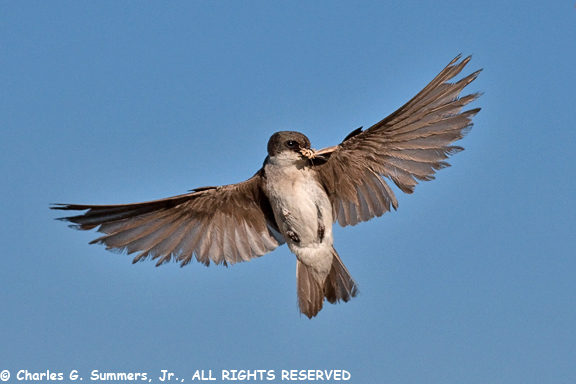
To avoid problems for Tree Swallow young, be certain your floors are at least 5″ x 5″, preferably more.
- Narrow, cramped designs like the Peterson, Gilbertson, Gilwood, and Troyer Bluebird Boxes are totally unacceptable for Tree Swallows.
- If you plan to buy from a store, bring a ruler along. Many of the boxes you’ll find will be too small for Tree Swallows (no matter what the clerk says). If they don’t measure up (literally), don’t buy.
- We are sorry to say this, but in our opinion the North American Bluebird Society and any of its member clubs and individuals that continue to promote the use of boxes with small interiors show a blatant disregard for the survival of other native cavity-nesting songbirds.
- For more on the sometimes contentious human attitudes regarding Bluebird – Tree Swallow relations see Reducing Bluebird versus Tree Swallow Competition.
And never offer those little decorative boxes!
- As you search for boxes you may find miniatures for sale, such as the one below in Sarah Rosedahl’s photo. Although cute, these boxes are not remotely roomy enough for proper development and survival of Tree Swallow broods.
- Buy and display these boxes inside your home for their decorative value if you wish, but please don’t put them out intending to attract nesting Tree Swallows, and if you do find swallows investigating, replace these boxes with suitably-sized ones.
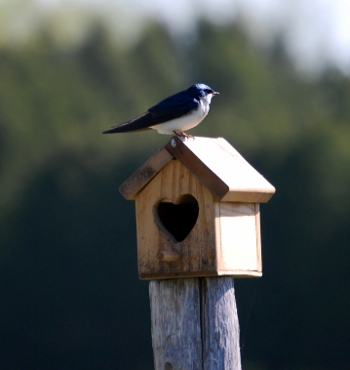
If you’re not convinced yet that it’s detrimental to use nest boxes for Tree Swallows that have small interiors, please compare the four nest box floors below.
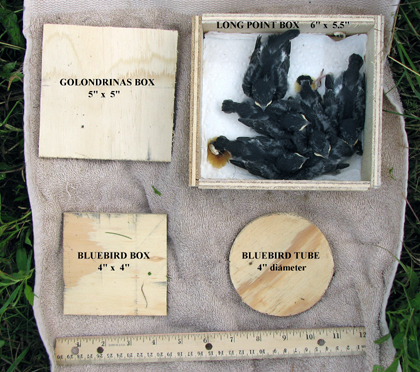
- Which of the above boxes would provide enough space for the typical brood of six swallow nestlings shown? These youngsters are only twelve days old and must continue to develop inside their nest box for another six to ten days before fledging. How many would you think could survive in the two bluebird-type boxes?
- Are you still not convinced small interiors can be detrimental for Tree swallow nestlings? If so, please watch these two YouTube videos of six nestlings crowded into a box whose 4.5 ” x 4.5″ interior is actually 27% larger than the 4″ x 4″ bluebird box above and 38% larger than the 4″ diameter bluebird tube.
- Video 1 shows Tree Swallow nestlings 15 and 16 days old.
- Video 2 shows Tree Swallow nestlings 18 days old, the day before they fledged.
- After having watched, ask yourself why anyone would ever deliberately offer anything even smaller than the box in the videos to their swallows?
But why would Tree Swallows even attempt to nest in tiny cramped boxes?
- We really don’t know why. Tree Swallows certainly don’t seem to use “selective judgement” in evaluating their choices.
- The shortage of natural cavities probably drives Tree Swallows to accept anything they can claim. But knowing swallows will use them we have a responsibility never to offer them bluebird boxes that are nothing more than miserable little death traps.
- And what about bluebirds? They’re larger than Tree Swallows! How could boxes with small interiors possibly be good for bluebirds?
- The fact is that the large-interior box designs we recommend for Tree Swallows are also very acceptable for bluebirds, (provided the entrances are made at least 1-1/2″). And also be aware that for many years 5″ x 5″ interiors were the accepted standard for bluebirds.
- Before ending this discussion of space we want to commend Purple Martin hobbyist organizations which now urge members to use larger compartments in their martin housing. We wish bluebirding groups would do the same.
Don’t be afraid to improvise.
- Since Tree Swallows are so very accepting in their choice of box designs you can be creative. But, just be sure to follow the minimum size guidelines presented above.
- For example note the clever box below, designed and made by Irena of Ottawa, Canada. It features feeding holes that can be opened to prevent one large nestling from monopolizing the food supply, a flip-up roof overlap, and a hinged side door. If you would like to try her design, click here: IRENA’S SWALLOW BOX.
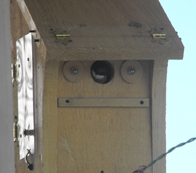
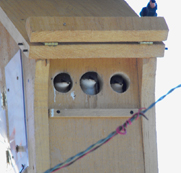
- And the very creative box below was designed by Bill Zagar of Michigan. It features a slot opening backed by a Conley II plate which combine to deter House Sparrows, a long interior making it difficult for mammalian predators to reach nests, and a shielded roof to prevent box overheating.
- There is extensive information regarding heat shields on the Sialis website..
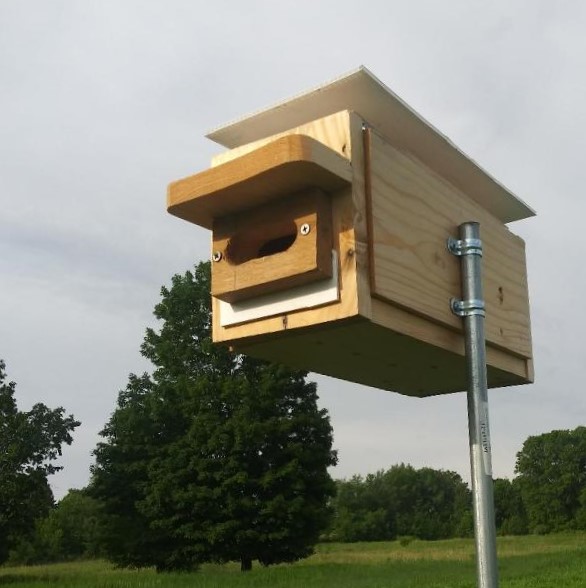
Consider installing a Nest Camera.
- Tree Swallows are so easy to watch we sometimes forget many vital behaviors and actions occur out of our sight inside their nesting cavities. But the advent of tiny remote-control cameras presents you the opportunity to view even those aspects of Tree Swallow life.
- We have never used nestcams ourselves. However, we know persons who have enjoyed them tremendously, who’ve spent many fascinating hours observing live video on their TV’s or computers as their swallows built nests, incubated eggs and raised young.
- To get a sense of what can be seen using nestcams check the Cornell Lab of Ornithology’s NestCam site. Be sure to visit Explore Archives.
- To learn about nestcam hardware and installation check the bluebird hobbyist web site Sialis’ excellent page on the subject.
- Be aware you may have to tweak your box design to accommodate a nestcam.
Buying Tree Swallow Boxes is an option.
- If you prefer to buy a box, Duncraft offers model # 2107, seen below, advertized specifically for Tree Swallows. Note its slotted entrance, which can prevent some, but not all, House Sparrows from entering.
- This box was quickly accepted and used successfully in our tests. However, its interior space is slightly smaller than we believe necessary for Tree Swallow nestlings, and we have stopped recommending it.
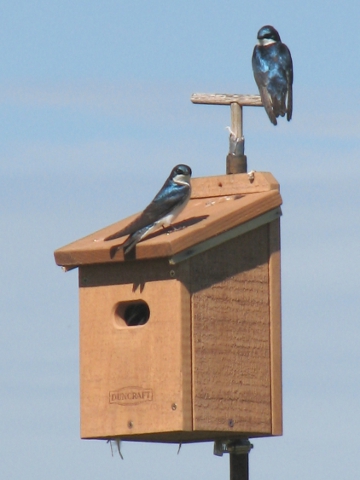
- Glenn Foote of Nova Scotia builds a CEDAR TREE SWALLOW NEST BOX that is spacious and hand-crafted of high-quality materials. Plus, his boxes are thoughtfully designed to incorporate many other features known to be beneficial for this species, including optional slotted entrances.
- You can purchase his box, seen below, by e-mailing g2foote@gmail.com.
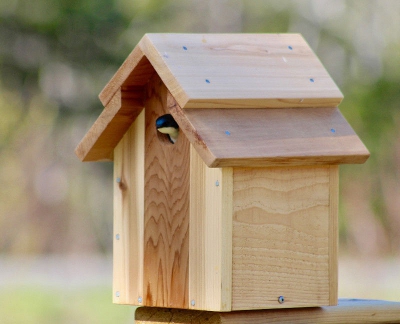
Another Option: Purple Martin Gourds.
- We’ve experimented with artificial Purple Martin gourds sold by S & K, with good results. They are inexpensive and roomy, and the Bo9 model can be fitted with a Tree Swallow-sized slotted entrance hole (See below). This is very important since most standard martin gourds have larger entrances which may allow Starlings to enter and destroy swallow nests.
- Please Note: The Tree Swallow entrance must be ordered separately.
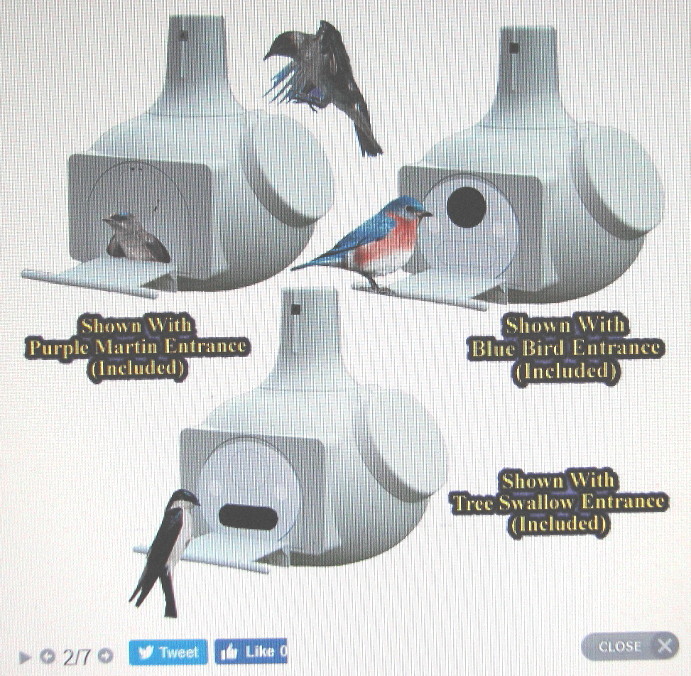
Martin Gourds plus Tunnels for extra protection
- You can use the martin gourds shown above as is, which is just fine in most cases.
- In some of our experiments we’ve taken an additional step to add an extra measure of predator protection to both Tree Swallow boxes and artificial gourds.
- Note below how we’ve added S & K “tunnels” in which we cut Tree Swallow-sized entrance openings, and removed porches and wing entrapment pieces.
- If this is something you might want to try here’s how we modify martin tunnels .
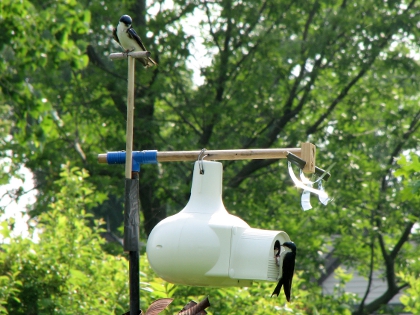
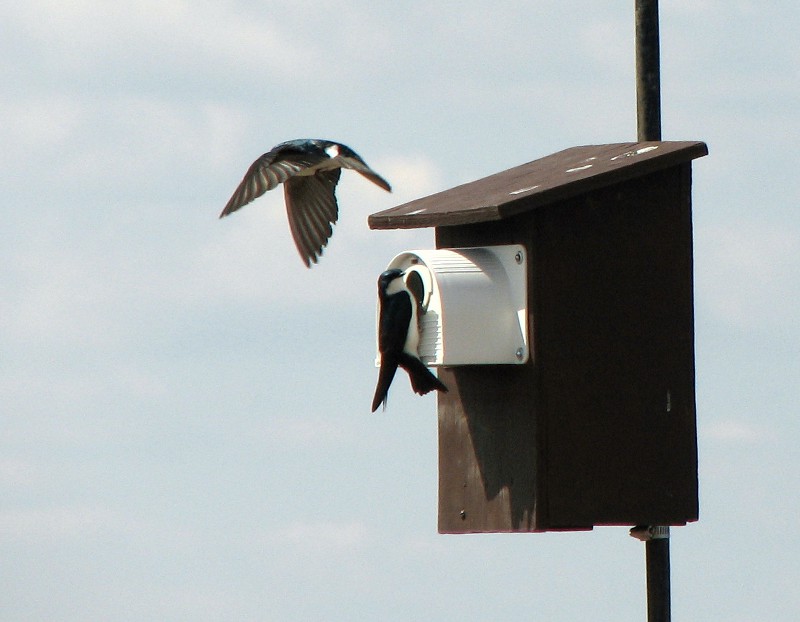
Natural Gourds
- Tree Swallows will also accept natural martin gourds, as the youngsters in Charlie Kelley’s photo below from Alabama demonstrate.
- However, if you decide to use any natural martin gourds be certain the entrances are sized for Tree Swallows. This means they should have either narrow slots or round entrances no larger than 1-1/2″ in diameter. Larger openings, like the one in this photo, may admit Starlings.
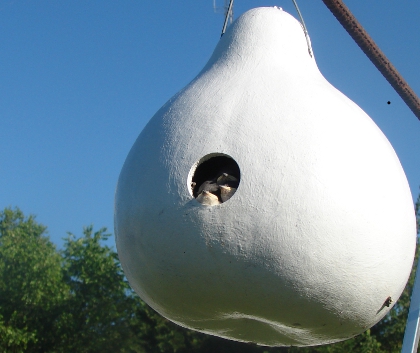
How many nest boxes for Tree Swallows should you build or buy?
- The best number depends on your habitat’s quality, the size of your field, and your energy and budget.
- 3 to 5 boxes is good for starters. That’s enough so you can see how individual swallows vary in behavior and nesting, but not so many that record keeping and box maintenance is a chore.
- But if you want to start with just one that’s perfectly ok. Just start. If you enjoy your swallows (and we know you will) you can always expand next year. Picture below from Jennifer Stanley in Kentucky.
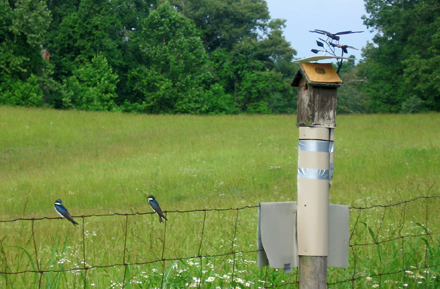
Next Step: Placing Tree Swallow Boxes
———————————————————————————
Home: Tree Swallow Nest Box Projects
Creating Tree Swallow Nest Box Projects
Spring Return
Nesting Season Behavior
Song and Calls
Nest Site Claiming
Pair Formation
Nest Building
Bird Flight
Mating and Paternity
Diary of One Season at Salmon Creek
Monitoring Nest Boxes and Keeping Records
Making Box Checks Keeping Box Records Control Sheets Season Summaries Print Sheets
Banding Your Tree Swallows Banding Adults Banding Nestlings
Tree Swallows in Research Research Bibliography Glossary of Terms